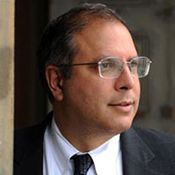This article was originally published in the 2017 Olin Business Magazine.
In 1983, Olin Business School Professor Philip Dybvig and Chicago Booth Professor Douglas Diamond published what would become a seminal paper in the field of financial economics, “Bank Runs, Deposit Insurance, and Liquidity,” which introduced an economic model that explained why banks are subject to runs.
The “Diamond-Dybvig model” quickly became synonymous with the study of banking, financial crises, liquidity, and bank runs. From academic conferences and economics courses to the hundreds of papers it has spawned, the model needs no introduction. Their paper has been cited more than 11,000 times since its publication in 1983.
[RELATED: The enduring relevance of Diamond-Dybvig]
35 years later, thought leaders in banking and finance continue to recognize the model’s relevance and influence:
 James Bullard, President and CEO, Federal Reserve Bank of St. Louis:
James Bullard, President and CEO, Federal Reserve Bank of St. Louis:
The rational expectations revolution swept economics during the 1970s, providing the profession with a consistent way to think about economic situations in which individual behavior today depends on expectations of the future, including expectations of future policy. Authors like Costas Azariadis, David Cass, and Karl Shell had shown that rational expectations equilibrium was not necessarily unique—many outcomes may be consistent with market clearing and rational expectations. Still, these were theoretical findings.
What sort of tangible situation might illustrate the power and importance of multiple equilibria for real-world problem-solving? Douglas Diamond and Philip Dybvig filled this role perfectly with an analysis of a problem—a bank run or financial crisis—that has haunted capitalist economies for centuries.
The hallmark of the model is that individual behavior depends in part on what everyone else is doing—if you are maintaining confidence in the bank, then so am I, but if you are running on the bank, then so am I. There are two possible outcomes, and the run equilibrium may be viewed as undesirable. As a bonus, Diamond and Dybvig suggested that public policy deposit insurance might work by eliminating the individual incentive to run on the bank, thereby restoring a unique equilibrium where confidence in the bank is maintained. This result helped to set an important precedent in the literature that is still reverberating today: In a model with multiple equilibria, the role of policy may be to “kill off” or get rid of the undesirable equilibrium outcomes, leaving only the desired equilibria as possibilities.
This concept is very different from ordinary policy analysis, which typically assumes a unique equilibrium outcome and provides advice on how to tweak that equilibrium. The 2007–09 global financial crisis could be viewed as Diamond-Dybvig writ large, with wholesale runs replacing the retail-level depositor run concept of the original model.
The global policy response since the crisis has principally been to raise capital requirements for financial institutions, on the thought that this would reduce, but not eliminate, the individual incentive to run. The notion of “eliminating the undesirable equilibrium” has not been the leading idea.
I think we may still have much to learn from the Diamond-Dybvig approach to financial crises in the years ahead.
 Paul Krugman in “If Banks Are Outlawed, Only Outlaws Will Have Banks,” The New York Times:
Paul Krugman in “If Banks Are Outlawed, Only Outlaws Will Have Banks,” The New York Times:
One of the great things about Diamond-Dybvig is that it immediately punctures any superficial notion that a bank can be defined by some traditional appearance—that it basically has to be a marble building with rows of tellers, i.e., a depository institution.
 Anil K. Kashyap, Professor of Economics and Finance at Chicago Booth, writing in the Chicago Booth Review:
Anil K. Kashyap, Professor of Economics and Finance at Chicago Booth, writing in the Chicago Booth Review:
Diamond and Dybvig were path-breaking when they proposed that banks specialized in creating liquid claims against illiquid assets.
Banking research prior to this point was pretty primitive. Banks were perceived as organizations that facilitated certain transactions for their customers, not as intermediaries that performed a unique service.
The basic structure of the model has become a platform on which hundreds of other banking-related models have been built. That is a testament to the fact that Diamond and Dybvig’s model appears to be simple, but can be extended to deliver insights about much more complicated environments.



